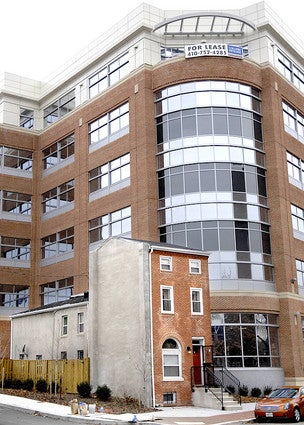Gentrification in the Age of Subprime

Lone rowhouse in Baltimore holds its own against modern development … credit Baltimore Sun
Feb. 20
By Thomas J. Walsh
For PlanPhilly
In the midst of the current housing crisis, with home values all over the map, it helps to keep an eye on the nation’s more stable markets – such as the Philadelphia region. It’s in those areas that an old maxim stills holds as true as the one about location, location, location: When property values go up in the suburbs, homeowners get excited; When they rise in city neighborhoods, residents get nervous.
Gentrification is alive and well, said two experts on the topic Thursday evening, at the latest in the “Philadelphia Conversations” series at PennDesign. John Kromer of Penn’s Fels Institute (and former Philadelphia housing director) and George Galster, a professor at Detroit’s Wayne State University and a specialist in neighborhoods, took turns interviewing each other for 90 minutes about “gentrification dangers and neighborhood change opportunities.”
The two were introduced by Penn School of Design Department Chair John Landis.
“We should be careful not to look at these questions myopically,” Galster cautioned at the outset of the conversation, preferring instead an approach to the subject that allows one facet of the debate to inform the next. What happens to a neighborhood is a function of how people and resources flow in and out, he said. Those flows are a reflection of that neighborhood’s relative competitiveness versus other neighborhoods or towns in the same metropolitan area. That competitiveness, in turn, “is crucially influenced” by socioeconomic factors.
Factors that contribute to the segregating effects of gentrification are by definition socioeconomic, Galster added: extreme concentrations of wealth on one hand and the forces of deprivation on the other.
That must be why long-time city residents get anxious when newcomers become many and house prices go up, Kromer suggested.
There goes the neighborhood
Of course, it’s a thornier issue than rich versus poor, or black versus white. In a town like Detroit, Galster said, “you do have significant political forces” in play that result in a certain dubiousness on the part of residents when their housing becomes pricier. But, “if we’re really interested in the wellbeing of the urban poor in our center city municipalities,” we cannot leave them bereft of a tax base, he added. Higher property values mean a better tax base, and that means people on the street with disposable incomes.
“Folks with disposable incomes create resources and jobs in their neighborhood,” Galster explained. The financial benefit to the jurisdiction results in jobs, too. The trick is finding out “how do you get the game without the biggest problems” – the expense of new rents, the affordability of moving, etc., and “how do you avoid that kind of displacement?” The answer is simply that many people, in many places, just don’t worry about it, he said.
There may be some practical solutions, though. “Requiring, in certain neighborhoods, minimum set-asides [of homes] at differing price points, so that gentrification occurs at the same time as diversification,” Galster suggested.
And what about tax increment financing? “To my knowledge, [TIFs] have never been used to avoid the negative effects of gentrification,” he said. “A bond to finance affordable housing opportunities, maybe, before the market does its thing.”
(In short, a TIF is a way of using public financing for redevelopment purposes, and is often used for infrastructure investment. It counts on future gains in taxes to finance the very improvements that will create those gains. The assumption is that a given project’s success will lead to an increase in the value of surrounding real estate, along with new investment, and thus, increased tax revenues, also called the incremental increase. TIFs are generally used in neighborhoods where development would otherwise likely not occur.)
Aiding and abating
Kromer took that as a cue to ask Galster’s opinion of the tax abatement that has been lauded as the Philly government policy tool most responsible for Center City’s turnaround over the past decade – driving up home values, re-populating the city and saving houses and larger buildings that were empty but have been converted to apartments, condominiums and offices.
Such abatements for new homes could cause division between new homeowners and long-established city residents, Kromer noted, often with the former having the more valuable property but the latter getting taxed at a higher rate.
Galster admitted that there could be some “very tough methodological issues to investigate” in such a scenario. But assuming the increased development happened only because of the abatement, he recommends asking an aggrieved party if they are better off because of their new neighbors. Questions of fairness cut both ways. That said, the neighborhood veteran would see taxes go up on his house because the development caused a reassessment. In that case, Galster suggested that incremental increases in taxables, or a certain percentage, be deferred until the sale of property. The deferment could be “scaled,” or means-tested, according to income.
Kromer recalled a conversation he had with a developer who has been active in the city. The developer’s stance was that Philadelphia’s challenge was to come up with one thing, a certain “something else” to counteract the city’s negatives – the wage tax, the political influence on the building trades, cumbersome permitting processes, the state of the public schools, crime, etc.
The tax abatement is that something else for many developers, Kromer said, asking Galster if things like set-aside requirements might hinder the progress that’s been made.
“I don’t mean to suggest that inclusionary housing or set-asides is the panacea,” Galster replied. “There are certainly a lot of market situations that simply cannot support them. … Things that work against the profitability of a project, especially when things are hanging by a thread because of other market situations,” is necessarily a deal-breaker. “So it’s clearly a device that would really only work in hot neighborhood market situations.”
Rent to own
When it was Galster’s turn to interview Kromer, he asked about the foreclosure problem. Kromer said he has several concerns related to the “ethic of homeownership” in the coming years.
The theory that renters are somehow inferior to owners because they supposedly have less of a stake in the community has been turned on it’s head, Kromer said. “We as a society have lowered the stake of responsibility that an individual needs to accept in order to become a homeowner.” With the people who take zero-down mortgages or accepted streamlined assistance in other ways, “where’s their stake in an ownership and are we really creating a problem?” Even with a tightening of credit standards, the larger myths about home buying remain. “I don’t see that discussion happening and I’m very concerned about that.”
There are some positive steps are being taken, such as court-sponsored programs to intervene in the foreclosure process in Philadelphia, allowing owners to show evidence of measures to negotiate a smaller payment. But there is still, overall, a worrisome separation of loan servicing banks and the banks who make loans.
“It seems to me going forward that if we get some court-mandated intervention, we could introduce new standards and a new level of responsibility to homeownership,” Kromer said. “And also local governments ought to get involved in acquiring properties that are scheduled for foreclosure if we’re going to start to make progress. It’s going to take forever, but if we start this month…”
Another option: Allowing owners to remain as renters, with an opportunity to pay off debt or buy the home back later. That would also address the growing problem of areas with large amounts of empty homes, all of them potential targets for vandals and decay.
Quoting a Pew study, Galster mentioned that in the next two years, some $365 billion of property value would be lost. In the context of local property taxes, shouldn’t municipalities be doing something? he asked.
“I think cities really have not done enough to get in the middle of this foreclosure process,” Kromer said. Often the city and county government are not collaborating. Even in Philly, where the city and county are one and the same, the sheriff is an independent elected official. The sheriff is responsible for foreclosures but does not partner with the city. “There is no working relationship that I’m aware of, and that’s a shame,” he said, particularly because the winner of a sheriff’s sale here is simply the highest bidder, with no regard to experience or intent.
In towns that coordinate the effort, instead of auctions, land banks can be formed where officials collect foreclosed upon properties and then decide what to do. Selling them off, combining them – whatever action is taken, the idea is to do it in a way that comports with neighborhoods plans and contributes to the betterment of the city.
“I guess the blessing for Philadelphia is that the impact is so much less than some of those cities in the Sunbelt,” said Kromer, who nonetheless urged perspective on the problem. “By the same token, in Philadelphia, public schools and workforce education efforts are the areas that we need to concentrate on.”
Contact the reporter at thomaswalsh1@gmail.com.
WHYY is your source for fact-based, in-depth journalism and information. As a nonprofit organization, we rely on financial support from readers like you. Please give today.






